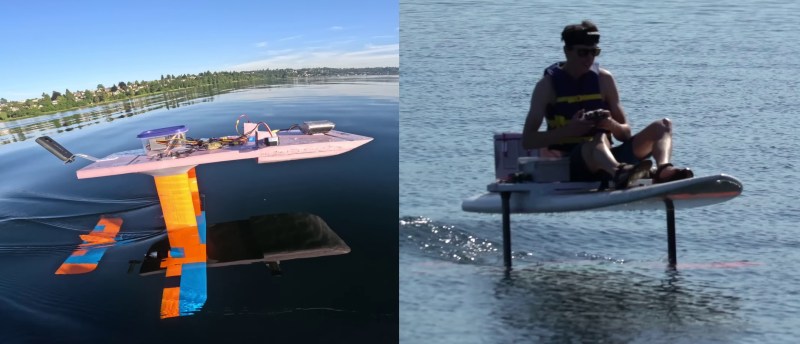Hydrofoils have been around for several decades, but watching a craft slice through the water with almost no wake never get old. In the videos after the break, [rctestflight] showcases his ambitious project: transforming a standup paddleboard into a rideable hydrofoil with active stabilization.
Unlike conventional electric hydrofoil boards that depend on rider skill for balance, [rctestflight] aims to create a self-stabilizing system. He began by designing a small-scale model, complete with servo-controlled ailerons and elevators, dual motors for differential thrust, and a dRehmFlight flight controller. A pair of sonar sensors help the flight controller maintain constant height above the water. The wings are completely 3D printed, with integrated hinges for flight control surfaces slots for wiring and control components. It’s better suited for 3D printing than RC aircraft since it’s significantly less sensitive to weight, allowing for more structural reinforcement. The small scale tests were very successful and allowed [rctestflight] to determine that he didn’t need the vertical stabilizer and rudder.
The full-sized version features a scaled up wing, larger servos and motors attached to an 11-foot standup paddleboard — minus its rear end — mounted on commercially available e-foil booms. A foam battery box stores a hefty LiFePO4 battery, while the electronics from the smaller version are repurposed here. Despite only catching glimpses of this larger setup in action at the end of the video, it promises an excitingly smooth lake ride we would certainly like to experience.
We’ve seen several 3D printed hydrofoils around here, but this promised to be the largest successful attempt. Don’t fail us [Daniel].
















Wow, so it IS possible!
I’ve been pondering this for ages, whether you could add a fly-by-wire system to a hydrofoil.
I was thinking about whether I could design a safer water-speed-record craft with fly-by-wire hydrofoils.
The record itself is near a suicide mission, everybody dies trying to beat it.
You could massively up the safety factor with this.
To go fast enough for the water speed record you need to use a jet engine, underwater propulsion (pump-jets) can’t deliver enough thrust at the speeds involved. The offset between the thrust above the waterline and the lift/drag below would make hydorfoils impractical.
All I had to do was see the headline and I knew who this was going to be.
Nice project, don’t forget to check out the github repo too.
I generated a 10 min audio summary here if anyone is interested, should give you enough info to decide if you should watch the longer video (you should!) https://notebooklm.google.com/notebook/543a6802-d769-4954-9b1f-e74e472f933d/audio
So… a unicycle is to a Segway what a regular foiling kite board is to this thing? Rad!!!